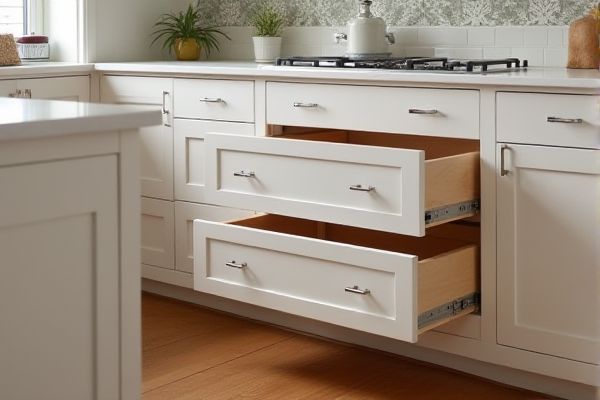
Full-extension drawers provide complete access to the drawer's contents, making organization and retrieval easier, while standard drawers only allow partial access, limiting visibility and reach. Discover which drawer type best suits Your storage needs by exploring the rest of the article.
Table of Comparison
| Feature | Full-Extension Drawers | Standard Drawers |
|---|---|---|
| Drawer Extension | Extend fully, 100% access | Partial extension, 50-75% access |
| Accessibility | Complete visibility and reach | Limited visibility, harder to reach back |
| Load Capacity | Typically higher load capacity | Lower load capacity |
| Soft-close Feature | Often integrated | Less common |
| Installation Complexity | More complex installation | Simple installation |
| Cost | Higher cost | Lower cost |
| Use Case | Ideal for full access and heavy storage | Suitable for light to moderate storage |
Introduction to Drawer Types
Full-extension drawers provide complete access to the drawer's contents by allowing the drawer to slide out entirely, maximizing storage space and convenience. Standard drawers typically extend only partially, limiting visibility and accessibility to items stored at the back. The choice between full-extension and standard drawers impacts functionality and ease of use in kitchen, office, and furniture design.
What Are Full-Extension Drawers?
Full-extension drawers are designed to pull out completely, allowing full access to the drawer's contents, unlike standard drawers which only open partially. These drawers feature advanced sliding mechanisms that enable you to see and reach items stored at the back without obstruction. By maximizing storage accessibility, full-extension drawers enhance organization and convenience in kitchens, offices, and furniture storage.
Understanding Standard Drawers
Standard drawers typically extend about two-thirds of their full length, limiting access to items stored at the back and reducing usable space. These drawers are often more affordable and easier to install but offer less visibility and convenience. Understanding the pull-out length and storage efficiency of standard drawers helps you decide if they meet your organizational needs.
Key Differences Between Full-Extension and Standard Drawers
Full-extension drawers offer 100% access to the drawer's interior, allowing users to see and reach items at the back easily, whereas standard drawers typically extend only 50-75%, limiting accessibility. Full-extension mechanisms use ball-bearing slides or telescoping rails for smooth, durable operation, in contrast to the simpler or less robust slides found in standard drawers. This enhanced functionality makes full-extension drawers ideal for kitchens, offices, and tool storage where maximizing usability and space efficiency is crucial.
Advantages of Full-Extension Drawers
Full-extension drawers provide complete access to the drawer's contents, allowing users to reach items at the back without obstruction. They maximize storage efficiency by utilizing the entire drawer depth, which is especially beneficial in deep cabinets. Enhanced durability and smoother glide mechanisms are common features, promoting ease of use and longer-lasting performance.
Benefits of Standard Drawers
Standard drawers offer a practical storage solution with durability and cost-effectiveness, making them ideal for everyday use in kitchens and offices. Their design provides sufficient access to contents while maintaining structural support, reducing the risk of drawer sagging or misalignment over time. Choosing standard drawers can optimize your space with reliable functionality and straightforward installation.
Space and Accessibility Comparison
Full-extension drawers offer superior accessibility by allowing you to pull the drawer out completely, granting full visibility and easy reach to all items stored inside. This design maximizes usable space compared to standard drawers, which only open partially, limiting access to items at the back and often requiring you to reorganize contents. Choosing full-extension drawers enhances organization efficiency and optimizes storage capacity in your kitchen or workspace.
Cost Considerations
Full-extension drawers generally cost more than standard drawers due to their advanced sliding mechanisms and higher-quality materials that ensure smooth, complete access to the drawer's contents. Investing in full-extension drawers can enhance functionality and convenience in your cabinetry, potentially increasing long-term value despite the initial higher expense. Standard drawers, while more budget-friendly, may restrict accessibility and limit storage efficiency, impacting overall usability.
Which Drawer is Best for Your Needs?
Full-extension drawers provide complete access to the drawer's contents, making it easier to reach items stored at the back without removing anything. Standard drawers typically extend only halfway, limiting visibility and access but often costing less and offering simpler installation. Choosing the best drawer depends on your storage needs and budget; full-extension drawers are ideal for maximizing space and convenience, while standard drawers may suffice for less frequently used items.
Conclusion: Making the Right Choice
Choosing between full-extension drawers and standard drawers depends largely on your storage needs and accessibility preferences. Full-extension drawers maximize usable space and provide easy access to items at the back, making them ideal for kitchens or offices requiring frequent retrieval of stored items. Your decision should balance budget considerations with the convenience and efficiency full-extension drawers offer compared to standard options.
 homyna.com
homyna.com